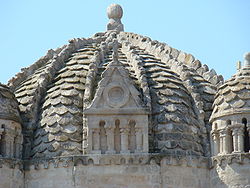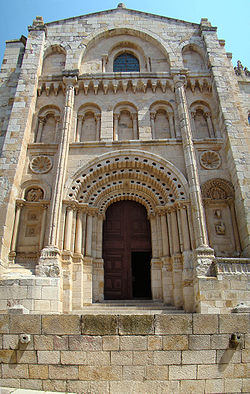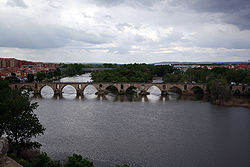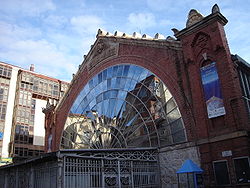
Zamora, Spain
Encyclopedia
Zamora is a city in Castile and León
, Spain
, the capital of the province of Zamora
. It lies on a rocky hill in the northwest, near the frontier with Portugal
and crossed by the Duero river, which is some 50 km downstream as it reaches the Portuguese frontier. With its 24 characteristic Romanesque style
churches of the 12th and 13th centuries it has been called a "museum of Romanesque art". Zamora is the city with the most Romanesque churches in all of Europe. The most important celebration in Zamora is the Holy Week in Zamora
.
the settlement was named by the Romans
, Occelum Durii or Ocellodurum (literally, "Eye of the Duero"). During Roman rule it was in the hands of the Vaccaei, and was incorporated into the Roman province of Hispania Tarraconensis
. It was on the road from Emerita (modern Mérida
) to Asturica Augusta (modern Astorga). (Ant. Itin.
pp. 434, 439).
Two coins from the reign of the Visigothic king, Sisebuto, show that it was known at the time as "Semure".
During the period of Moorish rule the settlement became known by the names of "Semurah" or "Azemur". After the establishment of the Christian Kingdom of Asturias
, the settlement became a strategic frontier post and was the scene of many fierce military engagements between the Muslims and Christians. Control of the town shifted between the two sides a number of times from the early eighth century to the late eleventh centuriy. During this period it became heavily fortified.
Henry IV granted Zamora the epithet of "most noble and most loyal city".

 The most notable historic episode in Zamora was the assassination outside the city walls of the king Sancho II of Castile
The most notable historic episode in Zamora was the assassination outside the city walls of the king Sancho II of Castile
in 1072. Some decades before, king Ferdinand I of León
had divided his kingdoms between his three sons. To his daughter, Doña Urraca, he had bequeathed the "well fortified city of Zamora" (or "la bien cercada" in Spanish). All three sons warred among themselves, till the ultimate winner, Sancho, was left victorious. Zamora, under his sister who was allied with Leonese nobles, resisted. Sancho II of Castile
, assisted by El Cid
, lay siege to Zamora. King Sancho II was murdered by a duplicitous noble of Zamora, Bellido Dolfos, who tricked the king into a private meeting. After the death of Sancho, Castile reverted to his deposed brother Alfonso VI of León. The event was commemorated by the Portillo de la Traición (Treason Gate). Zamora was also the scene of fierce fighting in the fifteenth century, during the conflict between the supporters of Isabella the Catholic and Juana la Beltraneja. The Spanish proverb, No se ganó Zamora en una hora, literally, Zamora wasn't won in an hour, is a reference to these battles. It is the Spanish equivalent of the English proverb "Rome wasn't built in a day."
During the 12th century, the city was extraordinarily important for its strategic position in the wars between the Kingdom of León
and Arabs to conquer the Iberian Peninsula
. As a result, the city preserves many churches and buildings from that time. In the next centuries, the city lost its political and economic relevance and suffered emigration, especially to South America (where many other cities called Zamora were founded).
.png) Zamora has a semi-arid climate, with cold winters and hot summers. Precipitation is mainly recorded in two seasons, spring and autumn, being summer characterized by droughts.
Zamora has a semi-arid climate, with cold winters and hot summers. Precipitation is mainly recorded in two seasons, spring and autumn, being summer characterized by droughts.
The highest temperature ever recorded is 41.0°C on 24 July 1995 while the minimum stood at -13.4°C on 16 January 1945.
Fog occurring frequently over the winter period, often lasting for days, has tended to lower the average temperature.

 Food specialities in Zamora include the pulses, the chickpeas from Fuentesauco or 'garbanzos', the exquisite cheese made from sheep's milk, honey from Sanabria, asparagus from Guareña, peppers from Benavente, steak from Aliste, mushrooms, game, cold meats, cakes and sweets.
Food specialities in Zamora include the pulses, the chickpeas from Fuentesauco or 'garbanzos', the exquisite cheese made from sheep's milk, honey from Sanabria, asparagus from Guareña, peppers from Benavente, steak from Aliste, mushrooms, game, cold meats, cakes and sweets.
Others are the rice dishes from Zamora and the Toro wines (very dark, almost black, nowadays made using modern techniques - with a rapidly growing reputation for their taste and quality).
Traditional dishes include bacalao a la tranca (a cod dish), el pulpo a la sanabresa (an octopus dish), dos y pingada (two fried eggs with fried ham, usually served in Easter) and presas de ternera (a veal dish). For dessert there is the rebojo Zamorano, a very tasty though hard type of bun, and las natillas almendradas (Spanish style custard with almonds).
, Portugal
(1984). Oviedo
, Spain
, since 2001. Yaritagua, Venezuela
. Altagracia de Orituco, Venezuela
Castile and León
Castile and León is an autonomous community in north-western Spain. It was so constituted in 1983 and it comprises the historical regions of León and Old Castile...
, Spain
Spain
Spain , officially the Kingdom of Spain languages]] under the European Charter for Regional or Minority Languages. In each of these, Spain's official name is as follows:;;;;;;), is a country and member state of the European Union located in southwestern Europe on the Iberian Peninsula...
, the capital of the province of Zamora
Zamora (province)
Zamora is a Spanish province of western Spain, in the western part of the autonomous community of Castile and León.The present-day province of Zamora province was one of three provinces formed from the former Kingdom of León in 1833, when Spain was re-organised into 49 provinces.It is bordered by...
. It lies on a rocky hill in the northwest, near the frontier with Portugal
Portugal
Portugal , officially the Portuguese Republic is a country situated in southwestern Europe on the Iberian Peninsula. Portugal is the westernmost country of Europe, and is bordered by the Atlantic Ocean to the West and South and by Spain to the North and East. The Atlantic archipelagos of the...
and crossed by the Duero river, which is some 50 km downstream as it reaches the Portuguese frontier. With its 24 characteristic Romanesque style
Romanesque architecture
Romanesque architecture is an architectural style of Medieval Europe characterised by semi-circular arches. There is no consensus for the beginning date of the Romanesque architecture, with proposals ranging from the 6th to the 10th century. It developed in the 12th century into the Gothic style,...
churches of the 12th and 13th centuries it has been called a "museum of Romanesque art". Zamora is the city with the most Romanesque churches in all of Europe. The most important celebration in Zamora is the Holy Week in Zamora
Holy Week in Zamora
This religious celebration, declared in the early 1980s of 'international touristic interest' is what the city of Zamora, Spain, is best-known for....
.
History
After the Roman victory over the Lusitanian hero ViriathusViriathus
Viriathus was the most important leader of the Lusitanian people that resisted Roman expansion into the regions of Western Hispania , where the Roman province of Lusitania would be established...
the settlement was named by the Romans
Ancient Rome
Ancient Rome was a thriving civilization that grew on the Italian Peninsula as early as the 8th century BC. Located along the Mediterranean Sea and centered on the city of Rome, it expanded to one of the largest empires in the ancient world....
, Occelum Durii or Ocellodurum (literally, "Eye of the Duero"). During Roman rule it was in the hands of the Vaccaei, and was incorporated into the Roman province of Hispania Tarraconensis
Hispania Tarraconensis
Hispania Tarraconensis was one of three Roman provinces in Hispania. It encompassed much of the Mediterranean coast of Spain along with the central plateau. Southern Spain, the region now called Andalusia, was the province of Hispania Baetica...
. It was on the road from Emerita (modern Mérida
Mérida, Spain
Mérida is the capital of the autonomous community of Extremadura, western central Spain. It has a population of 57,127 . The Archaeological Ensemble of Mérida is a UNESCO World Heritage site since 1993.- Climate :...
) to Asturica Augusta (modern Astorga). (Ant. Itin.
Antonine Itinerary
The Antonine Itinerary is a register of the stations and distances along the various roads of the Roman empire, containing directions how to get from one Roman settlement to another...
pp. 434, 439).
Two coins from the reign of the Visigothic king, Sisebuto, show that it was known at the time as "Semure".
During the period of Moorish rule the settlement became known by the names of "Semurah" or "Azemur". After the establishment of the Christian Kingdom of Asturias
Kingdom of Asturias
The Kingdom of Asturias was a Kingdom in the Iberian peninsula founded in 718 by Visigothic nobles under the leadership of Pelagius of Asturias. It was the first Christian political entity established following the collapse of the Visigothic kingdom after Islamic conquest of Hispania...
, the settlement became a strategic frontier post and was the scene of many fierce military engagements between the Muslims and Christians. Control of the town shifted between the two sides a number of times from the early eighth century to the late eleventh centuriy. During this period it became heavily fortified.
Henry IV granted Zamora the epithet of "most noble and most loyal city".


Sancho II of Castile
Sancho II , called the Strong, or in Spanish, el Fuerte, was King of Castile and León .He was the eldest son of Ferdinand I of Castile and Sancha of León, the eventual heiress to the Leonese crown...
in 1072. Some decades before, king Ferdinand I of León
Ferdinand I of León
Ferdinand I , called the Great , was the Count of Castile from his uncle's death in 1029 and the King of León after defeating his brother-in-law in 1037. According to tradition, he was the first to have himself crowned Emperor of Spain , and his heirs carried on the tradition...
had divided his kingdoms between his three sons. To his daughter, Doña Urraca, he had bequeathed the "well fortified city of Zamora" (or "la bien cercada" in Spanish). All three sons warred among themselves, till the ultimate winner, Sancho, was left victorious. Zamora, under his sister who was allied with Leonese nobles, resisted. Sancho II of Castile
Sancho II of Castile
Sancho II , called the Strong, or in Spanish, el Fuerte, was King of Castile and León .He was the eldest son of Ferdinand I of Castile and Sancha of León, the eventual heiress to the Leonese crown...
, assisted by El Cid
El Cid
Rodrigo Díaz de Vivar , known as El Cid Campeador , was a Castilian nobleman, military leader, and diplomat...
, lay siege to Zamora. King Sancho II was murdered by a duplicitous noble of Zamora, Bellido Dolfos, who tricked the king into a private meeting. After the death of Sancho, Castile reverted to his deposed brother Alfonso VI of León. The event was commemorated by the Portillo de la Traición (Treason Gate). Zamora was also the scene of fierce fighting in the fifteenth century, during the conflict between the supporters of Isabella the Catholic and Juana la Beltraneja. The Spanish proverb, No se ganó Zamora en una hora, literally, Zamora wasn't won in an hour, is a reference to these battles. It is the Spanish equivalent of the English proverb "Rome wasn't built in a day."
During the 12th century, the city was extraordinarily important for its strategic position in the wars between the Kingdom of León
Kingdom of León
The Kingdom of León was an independent kingdom situated in the northwest region of the Iberian Peninsula. It was founded in AD 910 when the Christian princes of Asturias along the northern coast of the peninsula shifted their capital from Oviedo to the city of León...
and Arabs to conquer the Iberian Peninsula
Iberian Peninsula
The Iberian Peninsula , sometimes called Iberia, is located in the extreme southwest of Europe and includes the modern-day sovereign states of Spain, Portugal and Andorra, as well as the British Overseas Territory of Gibraltar...
. As a result, the city preserves many churches and buildings from that time. In the next centuries, the city lost its political and economic relevance and suffered emigration, especially to South America (where many other cities called Zamora were founded).
Main sights
Main sights of Zamora include:- CathedralCathedral of Zamora, SpainThe Cathedral of Zamora is a church in Zamora, central Spain, located above the right bank of the Duero in the southern and rather higher part of the old town, and is still surrounded by its old walls and gates....
, in Romanesque style, dating to the 12th century, taking only 23 years to build. - Medieval castleCastle of Zamora, SpainThe Castle of Zamora is a Middle Ages fortress in Zamora, Spain. It stands northwest of the city's Cathedral.It features Pre-Roman foundations and a Romanesque general structure. It was built between the 10th and 12th centuries. It stands northwest of the Cathedral, with magnificent views of the...
. - Palacio de los Condes de Alba y Aliste, built in 1459 by the first Count of Alva y Aliste. It boasts a patio and staircase decorated with carvings by artists from LombardyLombardyLombardy is one of the 20 regions of Italy. The capital is Milan. One-sixth of Italy's population lives in Lombardy and about one fifth of Italy's GDP is produced in this region, making it the most populous and richest region in the country and one of the richest in the whole of Europe...
. - Calle Balborraz.
- Church of San Pedro y San Ildefonso, built from the 11th century, probably over a Visigothic temple. It was reformed in Romanesque style in the 12th-13th centuries, but was much renovated in the 15th and 18th centuries. It has presently a single nave with cross vaults
- Church of the Magdalena. The southern façade is in Romanesque style, dating back to the 13th century.
- Church of San Isidoro (12th century). It has one nave, having a square major chapel. The exterior features two ogival arcades with archivoltArchivoltAn archivolt is an ornamental molding or band following the curve on the underside of an arch. It is composed of bands of ornamental moldings surrounding an arched opening, corresponding to the architrave in the case of a rectangular opening...
s. - Church of San Claudio de Olivares, known from the 12th century. Of small size, it has a single nave with a presbyteryPresbytery (architecture)The presbytery is the name for an area in a church building which is reserved for the clergy.In the oldest church it is separated by short walls, by small columns and pilasters in the Renaissance ones; it can also be raised, being reachable by a few steps, usually with railings....
and a semicircular apse. The columns of the nave have carvings. - Church of San Juan de Puerta Nueva (12th century stained glass circular window, symbol of Zamora).
- Church of Santa María la Nueva (12th century, baptistery dating back to the 13th century).
- Church of Santiago de los Caballeros (11th century), located outside the city walls. El CidEl CidRodrigo Díaz de Vivar , known as El Cid Campeador , was a Castilian nobleman, military leader, and diplomat...
was created knight here. - Church of Santiago El Burgo (Southern façade, 12th century Romanesque)
- City walls: three walled enclosures dating back to the eleventh, twelfth and thirteenth centuries.
- Museo de Semana Santa de Zamora: Opposite the Church of Santa María la Nueva, dedicated to Semana Santa de ZamoraHoly Week in ZamoraThis religious celebration, declared in the early 1980s of 'international touristic interest' is what the city of Zamora, Spain, is best-known for....
the processions during which are celebrated with particular ceremony in Zamora. The museum holds a large collection of pasos, the figures which are carried in procession through the streets by various 'cofradías' or brotherhoods. See Holy Week in ZamoraHoly Week in ZamoraThis religious celebration, declared in the early 1980s of 'international touristic interest' is what the city of Zamora, Spain, is best-known for....
Surroundings
- ArcenillasArcenillasArcenillas is a municipality located in the province of Zamora, Castile and León, Spain. According to the 2004 census , the municipality has a population of 309 inhabitants....
church (15th century panels) - Hiniesta church (Gothic, sculptures and murals)
- The Church of San Pedro de la NaveSan Pedro de la NaveSan Pedro de la Nave is a Visigothic church in the town of Campillo, in the municipal unit of San Pedro de la Nave-Almendra, in the province of Zamora, Spain...
, (village of El Campillo - 12 km distant) was founded in the seventh century, rebuilt in the twelfth century, and is one of the three best-preserved Visigothic churches in all of Spain. It was moved stone by stone and then re-erected, owing to the construction of a reservoir on its original site.
Climate
.png)
The highest temperature ever recorded is 41.0°C on 24 July 1995 while the minimum stood at -13.4°C on 16 January 1945.
Fog occurring frequently over the winter period, often lasting for days, has tended to lower the average temperature.
Notable locals

- Leopoldo Alas, also known as "Clarín" was a Spanish novelist born in Zamora. A street in Zamora is named after him.
- Ángel NietoAngel NietoÁngel Nieto Roldán born January 25, 1947 in Zamora, was a multi-time Grand Prix motorcycle roadracing World Champion. He is one of the most successful motorcycle racers of all time, with 13 Grand Prix World Championships to his name....
: multi-time (or '12+1' as he puts it himself) Grand Prix motorcycle road racing World Champion. He is considered a national hero in his Spanish homeland. The local sports centre is named after him. Some sources mistakenly refer to him as being born in Madrid. - Agustín Remesal: Journalist working as a TVE correspondent. Also writer.
- Ramón Álvarez: Born in Zamora. Author of many of the figures or 'pasos' carried through its streets during the Holy Week.
- Emiliano Merchán: multi-time world champion in canoeing
- Carlos Llamas: national radio news presenter, died October 10, 2007.
Food

Others are the rice dishes from Zamora and the Toro wines (very dark, almost black, nowadays made using modern techniques - with a rapidly growing reputation for their taste and quality).
Traditional dishes include bacalao a la tranca (a cod dish), el pulpo a la sanabresa (an octopus dish), dos y pingada (two fried eggs with fried ham, usually served in Easter) and presas de ternera (a veal dish). For dessert there is the rebojo Zamorano, a very tasty though hard type of bun, and las natillas almendradas (Spanish style custard with almonds).
Sister cities
BragançaBragança (Portugal)
Bragança is a city and municipality in north-eastern Portugal, capital of district of Bragança, in Alto Trás-os-Montes subregion of Portugal. In 2001, the population of the municipality was 34,774, in an area of 1173.57 km².-History:...
, Portugal
Portugal
Portugal , officially the Portuguese Republic is a country situated in southwestern Europe on the Iberian Peninsula. Portugal is the westernmost country of Europe, and is bordered by the Atlantic Ocean to the West and South and by Spain to the North and East. The Atlantic archipelagos of the...
(1984). Oviedo
Oviedo
Oviedo is the capital city of the Principality of Asturias in northern Spain. It is also the name of the municipality that contains the city....
, Spain
Spain
Spain , officially the Kingdom of Spain languages]] under the European Charter for Regional or Minority Languages. In each of these, Spain's official name is as follows:;;;;;;), is a country and member state of the European Union located in southwestern Europe on the Iberian Peninsula...
, since 2001. Yaritagua, Venezuela
Venezuela
Venezuela , officially called the Bolivarian Republic of Venezuela , is a tropical country on the northern coast of South America. It borders Colombia to the west, Guyana to the east, and Brazil to the south...
. Altagracia de Orituco, Venezuela

